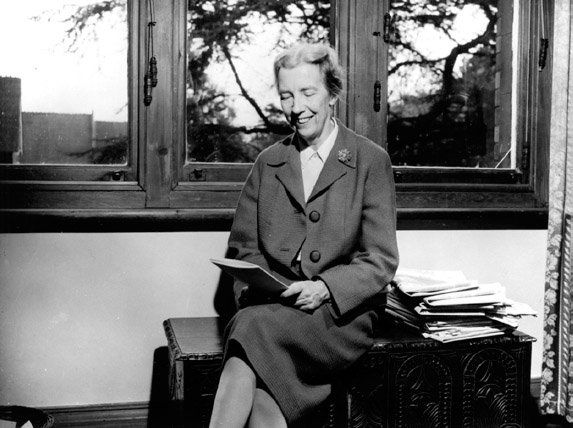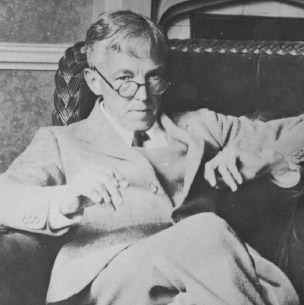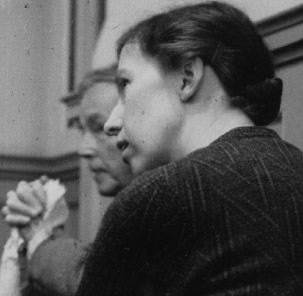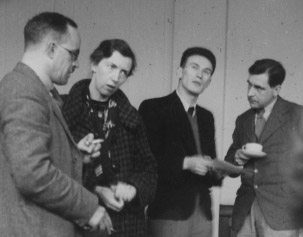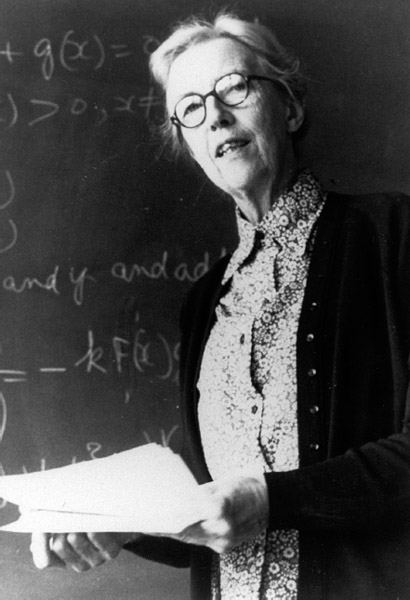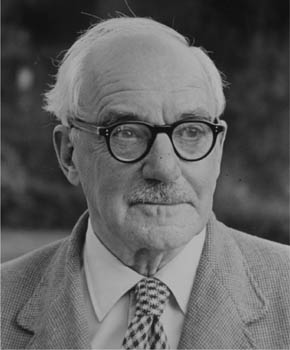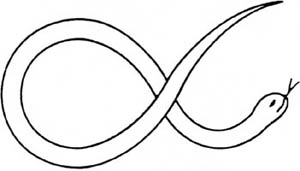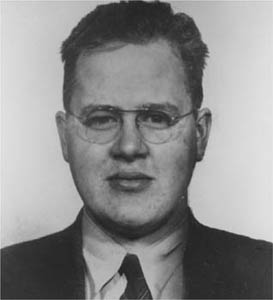Eight
Dame Mary L. Cartwright
Mary Cartwright was born December 17, 1900. She matriculated at St. Hugh’s, Oxford and was awarded a DPhil from Oxford in 1930. Her thesis advisors were G. H. Hardy and E. C. Titchmarsh. During her career she made important contributions to the theory of functions and differential equations. She is particularly well known for her work with J. E. Littlewood on van der Pol’s equation. Dame Mary was elected a Fellow of the Royal Society of London in 1947. She received the Sylvester Medal of the Royal Society and the De Morgan Medal from the London Mathematical Society. Cartwright served as president of the London Mathematical Society and of the Mathematical Association (British). She received honorary degrees from the Universities of Edinburgh, Leeds, Hull, Wales, Oxford, and Cambridge and became a Dame of the British Empire in 1969. She was Director of Studies in Mathematics and Mistress of Girton College and Reader in the Theory of Functions at Cambridge University. Dame Mary died in Cambridge, England, on April 3, 1998. The following interview was conducted in person and through correspondence during the period 1990–1994.
MP: Would you tell us about your family?
Cartwright: I am descended from the Cartwrights of Aynho in Northamptonshire. Richard Cartwright purchased the manor house and its grounds in 1616. His son John, who married the daughter of the attorney general to Charles I, remained a Roundhead and stayed in London during the Civil War. During the War the Aynho Park manor house was occupied by Cavalier soldiers, and John’s mother was imprisoned in Banbury. John’s only son William married Ursula, daughter of Fernando Fairfax. After their major defeat by Thomas Fairfax at the Battle of Nasby, the returning Cavalier soldiers burnt most of Aynho Park.
My great-great-grandfather married Mary Catharine Desaguliers, whose grandfather, J. T. Desaguliers, came over from France with his father, a Huguenot pastor, after Louis XIV revoked the Edict of Nantes in 1685. J. T. Desaguliers became Curator of the Royal Society and wrote books on physics. His son became a general in the army and brought back stones with inscriptions praising Louis XIV, which were inserted in the wall at Aynho Park. My great-grandfather, William Randolph Cartwright, lived in Rome for a time and then Florence, where he was a correspondent for the Spectator magazine. He returned to England and served as a liberal MP for Oxfordshire for more than forty years. He was married twice and had thirteen children, eight sons by his first wife and five sons by his second wife, Julia Frances née Aubrey.
Figure 8.1 Dame Mary Cartwright, 1965.
My father’s father was a colonel in the Grenadier Guards and served later as an MP for South Northamptonshire. My parents married in 1894 and lived at Church Cottage in Aynho, where my father served as curate to his uncle the rector. My father read history at Christ Church, Oxford. My mother was Lucy Harriet Maud Bury (rhymes with berry), and her father, Edward Bury, was a barrister who died in midcareer.
Early Life
MP: Would you give us a feeling for what your life was like in the early 1900s?
Cartwright: When I lived in Aynho, from 1900 until my father’s death in 1926, only four houses had tap water and proper drainage: the main house at Aynho Park, the grammar school, the estate agent’s house, and Church Cottage, where we lived before my father became the rector. Even these had rather inadequate plumbing. We used rain-water from the roof for sanitation, and sometimes water had to be pumped from a well. We left Church Cottage before I was six, but I remember it had a downstairs water closet.
MP: Did you have any brothers or sisters?
Cartwright: There were four other children in my family: John, Nigel (Walter Henry), Fred (William Frederick), and Jane. John Digby was born in 1895, and Nigel in 1897. John, from what my mother told me, had a great deal of charm from the time he was quite small onward and was a natural leader but very poor at learning to read and, later, at all schoolwork. He had to have special coaching to get into Sandhurst and became a second lieutenant in the 2nd Battalion of the Durham Light Infantry, the regiment of my father’s eldest brother Henry Aubrey. Nigel was larger and, as a child, more awkward but very much cleverer than John or I. John and Nigel got on very well together, and I, of course, admired them and always regretted having to turn back on Sunday walks because I could not go as far. Nigel was interested in carpentry and building with toys and bricks and good with boats. I watched his building and tried a little. I did not get very far; no ideas of my own was the trouble.
Nigel matriculated at Christ Church, Oxford, with a view to reading classics after the War [World War I]. He became an officer in the 2nd Battalion D. L. I. and was killed in 1917. John was also killed in the War. Neither has a known grave, but their names are inscribed on the Menin Gate at Ypres.
MP: Tell us about your younger brother and sister.
Cartwright: I was born in 1900, my sister Jane in September 1904, and my brother Fred in November 1906. Jane was a good deal larger than I, taller and broader, and grew a lot when she was quite young. This was embarrassing for her because, like John, she was slow to read and found spelling and all school work difficult. I wonder now whether she was dyslexic. Fred was much quicker but not outstanding until he got a job with a steel firm and got transferred from the London office to work in South Wales. As a child he used to do interesting things with a Meccano set and in carpentry, but at his preparatory school his reports varied up and down. When I coached him in Latin, he was moved up a form, which upset his mathematics for a bit. However, he settled down enough not to have serious difficulties.
Conic Sections Intriguing
MP: Tell us what you remember about your early education.
Cartwright: I tagged along after John and Nigel whenever I could. John went to school first, and one of the few things I remember before I was six is playing with Nigel in a yew tree near the village infant school. The mistress, daughter of the headmaster, gave Nigel a box of colored chalks and asked us to go away, which we did. John and Nigel were taught by the eldest daughter of an estate agent, and the schoolroom was built of corrugated iron leaning against the house. I think I must have been allowed to attend their lessons and given some help. I remember having a very old-fashioned chunky book with short words and black line illustrations. Much later I found a reading book of mine with words of five letters dated December 1905.
In the days at the rectory and early years at Leamington High School I avidly read Little Folks, a magazine for children published by Bella and Leonard Woolf. My mother took a lot of trouble to get educationally improving toys for us. There was an organization, the Parents National Educational Union, that helped provide materials and books for education at home. They offered a correspondence course to help governesses. My mother knew someone who belonged and got ideas and material from them. In particular, bricks, carpentry tools, and Meccano for my brothers, and for me a set of wooden models: sphere, cylinder, cone, and perhaps others. It was sections of the cone, the ellipse, hyperbola, and parabola, that intrigued me the most. Unfortunately, the little metal peg at right angles to the ellipse did not fit tightly enough to hold the top, which always pointed downwards as soon as I let go. The angle of the peg should have been slanted upwards. There was a geography book, but it was deadly dull, and I could not learn exports and imports without any explanations or pictures. There were also little arithmetic cards from the village school. I don’t know what ages they were meant for, but I suspect that I was doing thirteen- to fourteen-year-age cards before I was eleven.
Figure 8.2 Portrait of Dame Mary that “misses the warm sense of humor and sympathy that her friends and students knew.”
MP: How rigid were social distinctions in England in the period just before the First World War?
Cartwright: The country gentry did not mix socially with the farmers nor with people who actually lived in Banbury, the nearest town of any size. Brackley and Deddington were small enough for people in some of the larger houses to be acceptable. The children of the gentry could not possibly be sent to the village school, so the boys were sent to preparatory school from age eight or nine to age thirteen or fourteen and then to public schools until eighteen or nineteen. At this time, 1907–1910, there were various schemes for improving the education of girls. A few girls’ boarding schools comparable with boys’ schools like Harrow, Winchester, Rugby, and so forth, had been started, but the parents who lived in the great country houses usually preferred to have a resident governess, which was expensive. A friend about eight years older than I said once, “Oh yes, we had governesses. I got through nine.”
MP: The first secondary school you attended was Oxford High School. What do you remember about that experience?
Cartwright: Oxford was only eighteen miles away from Aynho by train, and the trip was familiar to me from quite early days. I had attended dancing classes in Oxford at the Randolph Hotel with about fifteen or twenty other children. We learned the polka, the waltz, and sang nursery songs with movements to the music. Mother bought a very small pink paperback in the series Books for the Bairns for me to read on the train. Nigel and I were often sent to stay with Aunt Rose, mother’s next eldest sister. Aunt Rose’s husband, Warner, was a tutor at Christ Church. I am afraid that I did not like staying with Aunt Rose. There was far too much white paint, and three mats to wipe your feet on at the front door, one outside and two inside. We had family prayers with the servants, except of course the cook, as at home. The gas fire in the breakfast room fascinated me, as did the stuffed duck-billed platypus on the piano. I think that the Oxford High School interlude was to get me used to being with children of my own age because it was so difficult to make contact with any in the neighborhood at Aynho.
Relativity and School Geometry
MP: You then went to the Leamington School. What kind of mathematical foundation did it provide?
Cartwright: I returned to school the following autumn to a higher form with my cousin Christine. We began Latin and the simplified Euclidean geometry which was done in all schools then, using a book by Hall and Stevens. It was soon superseded by the Godfrey and Siddons. Shortly thereafter, the Mathematical Association produced a report saying that proofs by superposition that triangles are congruent under certain conditions were invalid since the theory of relativity implied that things moving from one place to another at great speeds do not necessarily remain the same size. The report placed me in a very awkward situation several years later at the Wycombe Abbey School when I found myself teaching Siddon’s daughter using her father’s book and was obliged by the head of the department to tell her to cross out large portions of the text.
I liked geometry at Leamington, but there were times when I thought we would never get beyond multiplication of decimals. Mrs. Pochin, our teacher, had attended Newnham College, Cambridge. On one occasion she held forth about prime numbers and how difficult the problems about them were. I felt they were not for me. I wanted to solve problems and not get stuck. As it turned out, I never produced any new result in the theory of numbers but only toyed with the field in order to see what the difficulties were like.
MP: In the fall of 1916 your parents sent you to the Godolphin School in Salisbury, Wiltshire, about twenty-five miles north of Bournemouth. Isn’t that where you were first exposed to the calculus?
Cartwright: The Godolphin School was for girls only, many of whom were daughters of doctors, clergy, missionaries, and farmers. The residence accommodations were almost unbearably primitive and old fashioned. There were day girls as well as boarders, and some daughters of the owners of big shops in the town. It was during the war, so we never went into City Center except to the Cathedral Services on Sunday afternoons at 3:30 p.m. Each group walked there in crocodile fashion, that is, two and two with the house mistress at the back. It was rumored that Australian soldiers on leave might be dangerous, and so we went for walks in fours when it was not possible to play games. I had lost time by changing schools but was put into a small advanced section for mathematics taught by Miss E. M. Hancock. She had learned mathematics by reading tutorial books for the external University of London BA degree. I first learned about the calculus, analytical geometry, and uniform convergence from her. It was Miss Hancock who encouraged me into reading mathematics at Oxford.
College
MP: Oxford had several colleges open to women. Why did you choose to matriculate at St. Hugh’s rather than Lady Margaret Hall, Somerville, or St. Hilda’s?
Cartwright: My cousin, Cecily Ady, was a Fellow at St. Hugh’s and taught history. Her mother, Julia, née Cartwright, wrote well-known semipopular books on the history of Italian painters, and by her writing, which included a multitude of cheaper books and pamphlets, earned enough to pay for Cecily’s education. Julia, who resented not being allowed to learn Latin with her brother Chauncy, was taught German and other subjects considered suitable for girls. At the time, in order to enter Oxford, one had to pass an external examination in several subjects including arithmetic, the classics, and modern languages. My last year at Godolphin, I qualified by doing the Senior Cambridge Local and completing course work in Latin prose and Greek, which were then essential. I took the entrance examination to St. Hugh’s in the spring of 1917 in mathematics, which consisted, for me, of papers in pure maths only. I could not attempt the scholarship examination, which included statics and dynamics, because I had done no applied maths. Miss Hancock taught me a little science in the Summer Term and even rigged up an experiment to measure gravity. I cannot remember the precise details, but the experience put me off all experimental work. I think perhaps with respect to the sciences she did not prepare my mind enough. She was very good, but not successful with all the girls. Most upper-class girls were brought out, presented at Court, and spent a year or two attending all the fashionable functions, dances, racing, and so forth. They did not usually go to university.
MP: What did you do during the long vacations?
Cartwright: After my mother died I stayed with my cousin Di for a week and then again after the summer term every year until she gave up the house which she had built. It was thatched with Norfolk reeds and was so flimsy that it was a fire hazard, but she loved its rural appearance festooned with roses, wisteria, and jasmine. She would not let her own gardener cut anything because he would have been too drastic. But I cut a little the first day and a little more the second day. Every year she took me to a Shakespeare play at Stratford-on-Avon about thirty miles away. I remember A Midsummer Night’s Dream, Much Ado About Nothing, The Tempest, Macbeth, and Henry V. That is to say I remember something which makes me sure that I saw them. For example I thought that Prospero’s crown with lighted candles was dangerous and that the business with Banquo’s ghost was not well managed. We always had seats in about the third row where you could see the actors’ saliva when they were especially impassioned. Such are the memories which remain! The thing that pleased me most was that Di always booked lunch for us at a small hotel very near the theater.
MP: How difficult was it for you as a woman to read mathematics at Oxford?
Cartwright: I came up knowing that I was ill prepared. The honors maths course at Oxford consisted of passing the Mathematical Moderations, which can be taken in two years, or only one if you are well prepared, and then another two years of work for Finals. I had to take two years over Mods [preliminary examinations taken at Oxford two years before Finals], which made any university scholarship out of reach for me. At that time there was no money at all at St. Hugh’s for postgraduate work. In October 1919 the University was flooded with men released from the army and not nearly enough people to teach them. I managed to get copies of notes from J. W. Russell, who taught women from other colleges, but he would not undertake me and my two fellow students from St. Hugh’s. He did an enormous amount of teaching and lecturing for Balliol and wrote two books on geometry. The year before I took Mods, many men returned from war service and took the examination. An unusually large number of firsts were given, but in my year there were only three or four. I got a second and I had to choose whether to continue to Finals or to change to some other subject such as history. I decided to continue in maths largely because history seemed to entail longer hours of work. What really hooked me on mathematics was the calculus of residues. I should have mentioned that the Oxford system then, and for a long time thereafter, required students to go to a particular set of lectures given in the Colleges and have one hour per week of supervision alone or in pairs or possibly more, for which written work was required. I did not get very much out of those hours alone except at first. My first supervisor, L. J. Rogers, a good mathematician as I later found out, had retired from a professorship at Leeds but seemed bored. I was sent to J. W. Nicholson for one term of supervision before Finals and found him good. Unfortunately, it was in dynamics, which was not a subject that appealed to me at the time.
“I Owe My Career to Morton”
MP: How did you first meet G. H. Hardy?
Cartwright: Near the end of my third year at Oxford, one of the most important events in my mathematical career occurred at a party on a barge in Eights Week [the main annual rowing event held at Oxford in May on the Isis]. The men’s colleges had barges on the Thames that their rowing men used for changing. When the races took place there were parties on the roofs of the barges. Mildred Cousens had asked me to go with her to a party. The chaperone rules were very restrictive, and we avoided having to ask permission if possible. So I think it was probably okay for such a party if there were two women and two men. One of Mildred’s friends had asked V. C. Morton, later professor of mathematics at Aberystwyth, to the party. At one point during the evening Morton advised me, if I was serious about mathematics, to read E. T. Whitaker and G. N. Watson’s Modern Analysis and to attend Professor Hardy’s class, which took place once a week over the Holywell gate of New College Friday evenings from 8:45 p.m. to 11:00 p.m. I owe my career to Morton.
I read Modern Analysis during the following long vacation and got special permission to attend Hardy’s class. Hardy’s class consisted of a talk of about an hour always beginning fifteen minutes late. Afterwards we had tea and biscuits and talked about mathematics and mathematicians. Apparently, I impressed him very favorably for he was a Finals examiner when I got a first. One paper was so hard that no one seemed able to do more than twenty minutes work on the questions. Hardy took immense trouble with his students whether they were good, bad, or indifferent. Once, when I had produced an obviously fallacious result, Hardy said, “Let’s see, there’s always hope when you get a sharp contradiction.”
Hardy’s manners were peculiar. If he walked along a street he looked at the ground, only looking up occasionally. I think that if he saw someone he knew he would deliberately look the other way.
MP: What did you do after obtaining your degree from Oxford?
Cartwright: I taught mathematics for one year at the Alice Ottley School in Worcester. When they had to economize, I left, and I went to the Wycombe Abbey School, an expensive boarding school in High Wycombe, where I had to teach mathematics exactly in the way the senior mathematics mistress said. There was virtually no chance to experiment at Wycombe Abbey. Eventually I felt I had to try something else. I approached Professor Hardy in January of 1928 and arranged to attend his class for research students and work under him.
Being a Student of Hardy
MP: Would you describe what it was like to be a student of G. H. Hardy?
Cartwright: From 1920 to 1931 Hardy was the outstanding influence in pure mathematics at Oxford. I felt that I had joined a rather very special group when I began to attend Hardy’s class at New College in January 1928. He had just ceased to be secretary and was beginning his term as president of the London Mathematical Society. He was obviously strained and working very hard. Looking back, I think that we knew that we were studying under a very great man who had not yet been recognized fully. The members of the class included Gertrude Stanley, who had finished her course and was a lecturer at Manchester, and John Evelyn, a direct descendent of the famous diarist. Evelyn came only occasionally, and I assumed that he had obligations associated with his ancestral home in Wotton-under-Edge. Also there was E. H. Linfoot, L. S. Bosenquet, and an Indian named Vijayarhagavan who was so highly regarded by Hardy that he was selected to lecture when Edmund Landau paid a social visit. A Canadian, Frederick Brand, and I were also selected to speak before Landau. Gertrude Stanley said to me early on, “We all go to Hardy’s Monday class for undergraduates as well, but we don’t speak.” In his seminar one evening in 1928 Hardy gave us a list of problems. He was amazed when I did one completely by straightforward contour integration. My work appeared as an appendix to his book on divergent series.
Figure 8.3 G. H. Hardy
MP: Hardy was in the United States while you were working on your thesis. Did that cause you any problems?
Cartwright: From October 1928 to May 1929 Hardy exchanged jobs with Veblen of Princeton, a geometer. E. C. Titchmarsh was put in charge of me, and his suggestions suited me well. Titchmarsh had a job at University College, London, and also a Research Fellowship at Magdalen College, Oxford. We used to meet in his rooms in Trinity. He was a wealthy man with an estate in Northumberland. Tea was served on a silver tray from a silver teapot. Hardy returned from the United States in May 1929. I thought he looked very much better, and quite relaxed, but his hair had turned white. After his return I completed my DPhil. I successfully applied for a Yarrow Research Fellowship at Girton College, Cambridge. It was said that the degrees of PhD and DPhil at Oxford were only created about 1920, “for Americans.” In the early 1920s men who were interested in a research position job at Oxford were told to be content with the traditional BSc and not to go for a DPhil. In Cambridge and elsewhere jobs depended entirely on research and personal recommendations. The numbers involved were so small that everyone had personal contacts if they were any good at all, and this was true until after the Second World War. Very few people were graduate students at universities outside Oxford, Cambridge, and perhaps two or three of the London Colleges. Edinburgh developed a graduate school of modest kind among its junior lecturers, most of whom had no previous research experience. At Cambridge, a graduate scholarship would enable a good mathematician to write a dissertation which he could submit for a prize fellowship at his college. For example, at Trinity, to the best of my knowledge, there were no restrictions or duties, and the fellowship could be held for four years, after which the man’s prospects for a college lectureship were good if his research work was good. I regret to say that my impression when I began research was that, in general, less qualified men were tolerated and employed quite a lot in the University of Cambridge, which eliminated some quite good women from Cambridge.
Hardy Heckles Littlewood
MP: How did Hardy’s seminars at Cambridge differ from those you attended at Oxford?
Cartwright: When he returned to Cambridge, I asked Hardy if he would be offering a seminar similar to the evening sessions I had enjoyed at Oxford. He replied that he would probably come to some arrangement with Littlewood. Soon after, the Lecture List announced a Hardy-Littlewood class. While Littlewood was speaking at the first class, Hardy came in late, helped himself liberally to tea and began to ask questions. It seemed as if he were trying to pin Littlewood on details, whereas Littlewood was trying to illustrate the main point while taking the details for granted. An irritated Littlewood told Hardy that he was not prepared to be heckled. I don’t recall them ever being present together at any subsequent class. Thenceforth, Hardy and Littlewood alternated classes. Littlewood often did all the speaking on his turns. Hardy often invited others to speak during his classes. Eventually, Littlewood ceased to participate, even though the class continued to be held in his rooms. Consequently the class became known as “the Hardy-Littlewood Seminar at which Littlewood was never present.” Thereafter, Littlewood intermittently held his own unlisted lecture class, which Hardy recommended to a number of his students. R.E.A.C. Paley was by far the brightest of the group that worked with Hardy and Littlewood.
Figure 8.4 At Cambridge in 1938 at the Hardy-Littlewood Seminar, the young Ralph Boas, armed with an unobtrusive and quite secondhand camera, managed to catch a number of mathematicians unaware before he was “apprehended” by Mary Cartwright. In this photo, Mary Cartwright is seated next to G. H. Hardy.
Figure 8.5 Over tea, after a lecture at the Hardy-Littlewood Seminar, Mary Cartwright continues in conversation with another mathematician.
MP: Do you remember any of the other women mathematicians from your early days at Cambridge?
Cartwright: I remember Frances E. Cave-Browne-Cave, who was bracketed with the Fifth Wrangler on the 1898 Cambridge Mathematical Tripos. Hardy was Fourth Wrangler that year. Before becoming a Lecturer in mathematics and later Director of Studies at Girton, she [Cave-Browne-Cave] did statistical research with Karl Pearson at University College London. She was a Fellow of the Royal Astronomical Society and published papers in barometric statistics. Her sister, Beatrice, also read maths at Girton but took a second class on the Tripos. Frances Cave[-Browne-Cave] told me that once, while they were being taught by William Young, he kept tilting his chair until it slipped and he went under the table. With great difficulty she and the others refrained from laughing. He then got up and all he said was, “Take out a fresh sheet of paper.” Young married Grace Chisholm, whom he had tutored at Girton. They went to live abroad, do research, and raise a family. They had a very successful mathematical career.
MP: You have more than ninety mathematical publications chiefly on the theory of nonlinear ordinary differential equations, functions of a complex variable, and topology. Which of your articles are of significant importance to you?
Cartwright: My work on directions of Borel spreads over four issues of Comptes Rendus was mentioned by Georges Valiron in his lectures at the Zürich International Congress in 1932. I completed the work in two or three papers in the Proceedings of the London Mathematical Society in the 1930s leaving one theorem announced in the Comptes Rendus unproved. During the 1930s, E. F. Collingwood refereed nearly all my papers on entire integral functions in the Proceedings of the LMS and helped me a lot. Collingwood gave a proof of a theorem proved by Ahlfors while Littlewood was lecturing on multivalent functions. Having seen an early version of the paper on inequalities in the theory of functions, which appeared in the Mathematische Annalen in 1935, I applied Ahlfors’s result to multivalent functions.
Figure 8.6 Dame Mary lecturing.
Remaining at Cambridge
MP: What factors played a role in your decision to remain in Cambridge?
Cartwright: Hardy and Littlewood recommended that my Yarrow Fellowship be extended and I be appointed an Assistant Lecturer at Girton. In October 1949 I became Mistress of Girton. While at Cambridge I served on many committees and was always a halftime university lecturer until I was made a Reader. It was probably being head of a college and not having enough time for research students that stopped my promotion to professor.
MP: Why did you accept the top position at Girton knowing that it was going to interfere with your research?
Cartwright: I myself found it virtually impossible to refuse to be elected Mistress of Girton. On the other hand, because of that position and others I have held, I felt favored and preferred to men on many occasions. In particular, on a number of occasions I have been asked to represent the London Mathematical Society, the Cambridge Philosophical Society, and Cambridge University. I served as chairman of the Faculty Board at the university, two terms of office on the Council of the Senate, the senior body at Cambridge University, and on the Council of the Royal Society. These were not salaried jobs. I paid my own way to attend numerous conferences, whereas a married man, or woman, probably couldn’t afford it. Some of the most outstanding male mathematicians did a prodigious amount of work in their heyday. I could not compete.
MP: Tell us about your research students at Cambridge.
Cartwright: My research students were not very numerous. Being Mistress of Girton was too demanding and time consuming. I refused to take on extra work if I could help it. Littlewood took over Chike Obi, a self-taught Nigerian, and pushed him through a PhD. Obi is now retired from Lagos University and is a great man in his own country. Sheila Scott MacIntyre married before taking her PhD. Hilary Shuard did not get a PhD, but is prominent now in the teacher training world. Barbara Maitland became a Lecturer at Liverpool. Her career was upset by the Second World War, but she managed to survive. James Ejeito served as vice-chancellor of Nsukka University of Nigeria. Carl Lindon taught at University College of Swansea. I examined Noel Lloyd for his PhD and have maintained contact with him. W. K. Hayman, FRS, my star pupil, won the LMS Berwick Prize and taught at Imperial College before moving to York University.
Figure 8.7 J. E. Littlewood.
Working with Littlewood
MP: You collaborated with J. E. Littlewood on several papers. Describe what it was like to work with Littlewood.
Cartwright: I first met Littlewood in June of 1930 when he came to Oxford to examine me for my Doctor of Philosophy degree. Later at Cambridge I attended a series of courses he offered on the theory of functions. Our work together began with a request in January 1939 from the Department of Scientific and Industrial Research for help in solving certain very objectionable looking differential equations occurring in connection with radar. At the time I had been in the habit of showing Littlewood anything which I thought would interest him. I read a summary by Balthasar van der Pol of work up to 1932 and studied the references back to work by Edward Appleton and van der Pol in 1920. I told Littlewood of some of the nonlinear problems which seemed to arise. We translated problems which were suggested by radio waves and oscillations into dynamical problems. He solved or half-solved several of the problems and suggested methods to handle the other problems. There was an odd phenomenon occurring with an odd nonlinear function mentioned in a short letter to Nature where van der Pol suggested that it occurred with a similar even nonlinear function. That was the only case that really interested Littlewood. He gave me the impression that this was an exciting problem and he would be interested in any significant progress I could make towards its solution. Meanwhile, in one of Edward Collingwood’s classes, I had learned of Ahlfors’s distortion theorem. While taking a bath one night, I saw how to apply it and Montel’s normal families to the problem. When I later settled down to examine the problem more carefully, I fell into the “usual trap.” The proof for the case p = 1 was known, and I tried to prove the case for p > 1 using a minor modification of that proof rather than my original idea. I sent this attempt to Littlewood. In reply I received a note with a sketch of a snake signifying that there was an obvious error in my proof. Returning to my original idea, I sent a new proof to Littlewood using Ahlfors’s work. Some time later, while punting with the Vice-Mistress of Girton on the River Cam near Trinity College, I spotted Littlewood on a nearby bank. As I had received no reply regarding my revised proof, I asked him if he had read my manuscript. He said, “Have I got to read all that?” I convinced him that he should, and when he had he was favorably impressed with my work. We collaborated in proving all solutions bounded, without which all other work was invalid. After a few years I got fed up with incessant changes, and we separated. I left it to him to complete the proofs of the most difficult problems, and I picked up the other bits and pieces.
Figure 8.8 Littlewood’s snake.
MP: How did your collaboration with Littlewood compare to that of Hardy and Littlewood?
Cartwright: My collaboration with Littlewood was unlike his with Hardy in one respect. He would not let me put his name to any paper not actually written by him. I had to say it was based on joint work with him. There was one exception, a fixed-point theorem on which he gave way on condition that it was checked by someone acceptable to him. The paper was published and later referred to in a subsequent article by M.H.A. Newman in his presidential address to the London Mathematical Society.
Littlewood was always more ready to talk out of doors. He never discussed problems with me at a blackboard, but he would draw imaginary figures on a wall as we walked and talked. I ran into him quite unexpectedly once on the Madingley Road. As we spoke one lens fell out of his glasses. It was in the days of clothes rationing and the knees of his trousers were torn and mended, one by a safety pin. He apologized, adding that he had not planned to call on a lady that afternoon.
Once we began to collaborate, nearly all of our collaboration was done by letters with occasional short discussions of particular points. I was occasionally able to catch him on the telephone after late tea and before his early dinner. I should mention that Littlewood suffered, so he said, from depression from 1931 until about 1956. All my work with him was done during his worst years. Littlewood was a very great mathematician. He once told me, and I agree, that in true collaboration the authors do not know who had which idea first. I believe that his work with Hardy is more important than the work done by either of them separately. I also think that he could not have achieved as much if he hadn’t let Hardy write up the final versions of much of their joint work.
Solomon Lefschetz
MP: In 1949 you were a consultant to the United States Navy. How did that come about?
Cartwright: Nicolai Minorsky’s book had come to my notice. It was a translation of a Russian work judged to be relevant to war-related problems and named [Solomon] Lefschetz as head of the project under the Office of Naval Research. I wrote to Lefschetz at Princeton telling him about the nonlinear differential equations that Littlewood and I were working on. From January to June 1949 I was in the United States. I spent three weeks in January at Stanford with John Curtiss and one week in Los Angeles, where Minorsky worked. From February to June I had an office in Fine Hall at Princeton. My agenda was arranged by Mina Rees. Officially, I was a consultant under the Office of Naval Research at Princeton because the university didn’t have women professors there, except one without tenure who taught Russian. I got on well with all those I met. Bochner was not on speaking terms with Lefschetz, so I never saw him. John Tukey told me that I ought to put my feet on the table in the seminar room, but, wearing a skirt and not trousers, I refrained. I listened in on a PhD exam of a good candidate who passed, but Lefschetz said that one of the candidate’s statements was wrong. The candidate came to me with a reference indicating that he was right.
Figure 8.9 John Tukey.
I learned that if Lefschetz stopped asking questions for five minutes he was asleep. On at least one occasion, he asked me to explain what a visiting lecturer had said. As you probably know he was trained as an engineer but lost both hands in an accident and turned to maths. I believe that he did outstanding work in topology during his work in some Middle-West job. In my opinion he was no good at differential equations, but of course he had a feeling for the applications and general background and liked organizing things. While at Princeton, I gave a seminar, and my lectures were published in the Princeton Series of the Annals of Mathematics.
MP: Would you comment on your membership in the Royal Society of London?
Cartwright: Women have been admitted to membership in the Royal Society since 1945. Almost all such women work in the biological sciences. I was elected in 1947. The second female mathematician, Dusa McDuff, was elected in 1996. Very few women have been elected to the Royal Society who combine teaching and research; still fewer combine marriage and the Royal Society.
Figure 8.10 Dame Mary Cartwright with Lord Butler and Lord Adrian, escorting Lord Adrian to his installation as Chancellor of the University, June 1968.
MP: Would you leave us with a bit of your philosophy?
Cartwright: Before Littlewood and I started collaborating, except for his work on anti-aircraft fire during the First World War, there seemed to be a deep divide between pure and applied maths. I am of the opinion that the dividing line between strictly abstract reasoning and thinking in terms of real-world problems is by no means clearly defined. A number of major developments in pure maths were first thought out in terms of real-world situations. Nevertheless, various aspects of mathematics attract different people who are left cold by others. I have obtained immense satisfaction from doing mathematics. My method was to polish and polish and, when the work had been published, to destroy all earlier versions. Mathematics is a young person’s game mainly because major advances in the subject come from approaching problems from a slightly different perspective than previously adopted. These types of ideas often come in the course of learning a subject for the first time. Younger mathematicians have slightly different backgrounds, find it easier to learn new subjects, have been trained in newer methods in allied fields, and are not afraid to experiment with new techniques. It is easier for older mathematicians to let ideas and methods become fixed and to fill their time with other interests.
![]()
REFERENCES
Cartwright, M. L. “Non-linear vibrations: A chapter in mathematical history.” Mathematical Gazette, 36 (1953): 81–88.
———. “Mathematics and thinking mathematically.” American Mathematical Monthly, 77 (1970): 20–28.
———. “Some points in the history of the theory of nonlinear oscillations.” Bulletin of the Institute for Mathematics and Its Applications, 10 (1974): 329–33.
———. “John Edensor Littlewood, FRS, FRAS, hon FIMA.” Bulletin of the Institute for Mathematics and Its Applications, 12 (1976): 87–90.
Godfrey, C., and A. W. Siddons. Modern Geometry. Cambridge: Cambridge University Press, 1908.
McMurran, S. L., and J. J. Tattersall. “The mathematical collaboration of M. L. Cartwright and J. E. Littlewood.” American Mathematical Monthly, 103 (1996): 833–45.
———. “Cartwright and Littlewood on Van der Pol’s equation.” Contemporary Mathematics, 208 (1997): 265–76.

